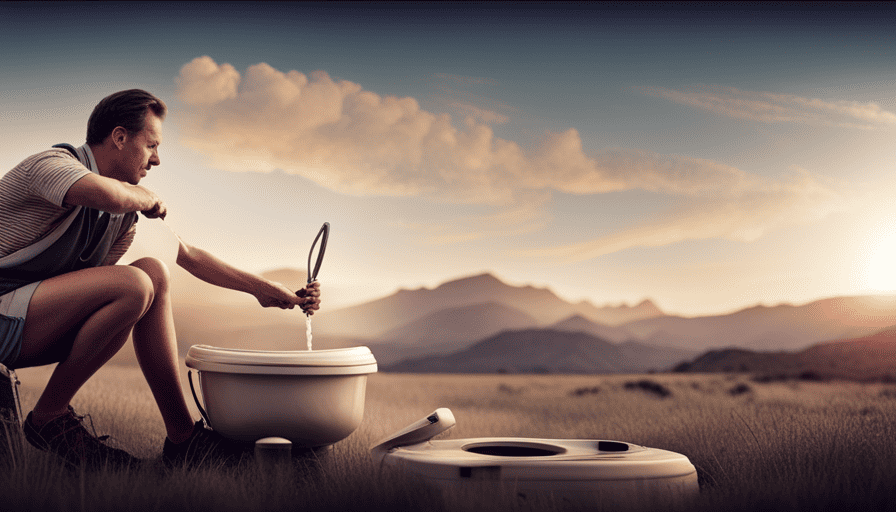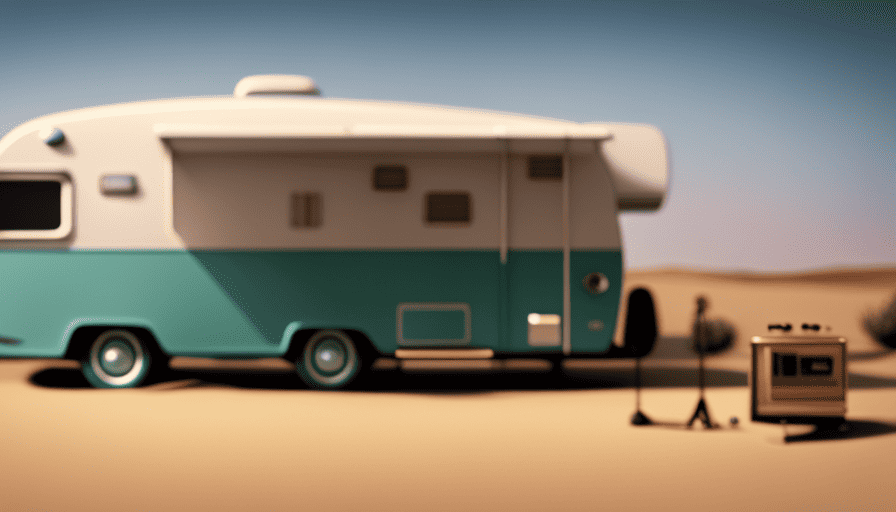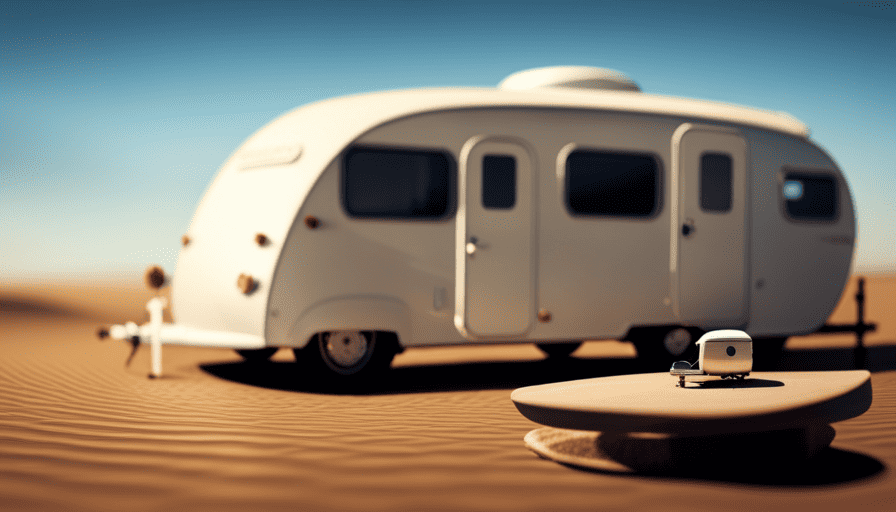Tired of dealing with unpleasant odors and clogs in your RV’s bathroom? Look no further! This guide will walk you through the step-by-step process of properly flushing your RV toilet. Say goodbye to frustrating moments and hello to a seamless, pleasant camping adventure.
Just imagine a toilet that flushes effortlessly, leaving no trace of waste behind. Picture yourself confidently navigating the ins and outs of your camper’s toilet system, knowing exactly how to keep it clean and functioning smoothly. With the right knowledge and techniques, you can achieve all of this and more.
In this article, I will provide you with detailed instructions on how to flush your camper toilet effectively. From familiarizing yourself with the toilet system to properly disposing of waste, I will cover it all.
So, let’s dive in and discover the secrets to maintaining a pristine and odor-free camper toilet.
Key Takeaways
- Familiarize yourself with the camper toilet system and its components
- Regularly empty and clean the waste holding tank to maintain cleanliness and prevent odors
- Use the right amount of water during flushing to prevent clogs
- Follow proper disposal and cleaning procedures for a hygienic camping experience
Familiarize Yourself with the Toilet System
Before you can effectively flush the camper toilet, it’s important to familiarize yourself with the toilet system so that you can confidently handle any potential issues that may arise. Understanding the plumbing of the toilet system is crucial in ensuring its proper functioning.
The system typically consists of a freshwater tank, a waste holding tank, and a flushing mechanism. To begin, locate the freshwater tank, which is responsible for providing water for flushing. Make sure it’s filled with clean water before use.
Next, identify the waste holding tank, where all the waste is stored. It’s essential to regularly empty and clean this tank to prevent unpleasant odors and blockages. Troubleshooting common issues is also part of familiarizing yourself with the toilet system. Sometimes, the flushing mechanism may become clogged or malfunction. In such cases, it’s helpful to have a plunger or a toilet auger on hand to address the issue.
Additionally, understanding how to check and replace the toilet’s seals and valves can help prevent leaks and ensure a proper flush. Now that you have a good understanding of the toilet system, let’s move on to the next step: using the right amount of water.
Use the Right Amount of Water
To ensure a smooth operation, make sure you’ve got just the right splash of water swirling around in the bowl. When it comes to flushing a camper toilet, using the right amount of water is crucial. Not only does it help maintain a sanitary environment, but it also contributes to reducing water consumption, making it an eco-friendly choice.
To illustrate the importance of using the right amount of water, let’s take a look at this 2-column, 5-row table:
| Insufficient Water | Excessive Water |
|---|---|
| Inadequate flushing | Wasting water |
| Increased odors | Potential leaks |
| Clogging | Increased weight |
By using the appropriate amount of water, you can avoid these issues and ensure the efficient functioning of your camper toilet. To reduce water consumption, consider eco-friendly toilet options that are designed to use less water per flush. These options not only contribute to environmental sustainability but also help conserve water resources.
In the next section, we will explore another important aspect of maintaining a camper toilet: adding chemicals for odor control. It is crucial to address odors effectively, and utilizing specific chemicals can help achieve this.
Add Chemicals for Odor Control
Make sure you add chemicals for odor control to keep your camping experience fresh and enjoyable. Here are three important things to consider when using chemicals for odor control in your camper toilet:
-
Chemical Safety: When choosing chemicals for your camper toilet, it’s vital to prioritize safety. Look for products that are specifically designed for RV or camper toilets and follow the manufacturer’s instructions carefully. Always wear gloves and ensure proper ventilation when handling these chemicals.
-
Alternative Options: If you prefer to avoid using chemicals in your camper toilet, there are alternative options available. Some campers choose to use natural enzyme-based products that break down waste and control odor without the use of harsh chemicals. Additionally, you can also consider using biodegradable toilet paper to help reduce waste buildup and minimize odors.
-
Proper Application: To effectively control odors, add the recommended amount of chemicals to your camper toilet after flushing. This will help break down waste and neutralize odors. Remember to follow the instructions on the product packaging to ensure you’re using the correct amount.
By adding chemicals for odor control in your camper toilet, you can ensure a more pleasant camping experience. However, it’s equally important to flush regularly and thoroughly to maintain a clean and odor-free toilet.
Flush Regularly and Thoroughly
Regular and thorough flushing is essential to maintain a clean and odor-free toilet in your camper. Regular maintenance of your camper toilet includes flushing it regularly and thoroughly. Efficient flushing not only helps to eliminate odors, but also prevents the build-up of waste and keeps the toilet functioning properly.
To ensure efficient flushing, start by pressing and holding down the flush lever or button for a sufficient amount of time. This allows the water to flow through the toilet bowl and effectively carry away any waste. Make sure to flush several times if needed, especially after each use.
Additionally, it’s important to use enough water during the flushing process. This helps to fully flush down any waste and prevents clogs. Some camper toilets have a water-saving feature, but it’s still crucial to use an adequate amount of water for a thorough flush.
By regularly and thoroughly flushing your camper toilet, you can maintain a clean and odor-free environment. This not only improves the overall camping experience but also ensures the longevity of your toilet system.
Next, I’ll explain the proper way to dispose of waste, which is an important aspect of maintaining a clean and functional camper toilet system.
Properly Dispose of Waste
Ensure your waste disposal is done correctly to maintain a hygienic and hassle-free experience while camping. Properly disposing of waste is crucial to prevent any contamination and maintain proper hygiene.
When it comes to camper toilets, there are a few important steps to follow. First, make sure you have a designated waste disposal area or a portable waste tank. This will allow you to collect and contain the waste properly.
When emptying the waste tank, remember to do it at an appropriate dumping station to ensure proper disposal. It’s essential to wear gloves and use disinfectant wipes to clean the area after emptying the tank to minimize the risk of spreading bacteria. Additionally, always use biodegradable toilet paper to reduce environmental impact.
By following these waste disposal guidelines, you can ensure a clean and sanitary camping experience. Moving forward to the next section on how to clean and maintain the toilet system, it’s important to establish a regular cleaning routine to keep your camper toilet in optimal condition.
Clean and Maintain the Toilet System
To keep your toilet system in good condition, it’s important to establish a regular cleaning routine that includes disinfecting and maintaining the proper water levels. Cleaning the toilet tank is a crucial aspect of maintaining the overall functionality of your camper toilet.
Start by turning off the water supply to the tank and flushing the toilet to empty it. Next, remove the tank lid and inspect the components for any signs of wear or damage. Use a mild detergent or vinegar solution to clean the inside of the tank, making sure to scrub away any mineral deposits or debris. Rinse thoroughly before reattaching the lid.
Cleaning the toilet bowl is equally important for maintaining hygiene and preventing odors. Start by applying a toilet bowl cleaner or a mixture of baking soda and vinegar to the inside of the bowl. Use a brush or sponge to scrub away any stains or residue, paying extra attention to the rim and under the rim. Flush the toilet to rinse away the cleaner and repeat if necessary.
To transition into the subsequent section about using RV-friendly toilet paper, it’s essential to ensure that the toilet system is clean and well-maintained.
Use RV-Friendly Toilet Paper
Using RV-friendly toilet paper is crucial for preventing clogs and maintaining a healthy septic system, as the adage goes, "An ounce of prevention is worth a pound of cure." Regular toilet paper may not break down easily in the RV’s black water tank, leading to blockages and costly repairs. RV-friendly toilet paper is designed specifically to break down quickly and completely, ensuring proper functioning of the system.
To understand the importance of RV-friendly toilet paper, let’s compare its breakdown capabilities with regular toilet paper in the following table:
| Toilet Paper Type | Breakdown Time |
|---|---|
| RV-friendly | Rapid |
| Regular | Slow |
As you can see, RV-friendly toilet paper breaks down much faster than regular toilet paper, reducing the risk of clogs and the need for expensive repairs. It is formulated to dissolve easily when exposed to water and agitation, making it ideal for RV toilet systems.
While some RV owners may consider using alternatives such as tissue or wet wipes, these can also cause clogs and damage to the septic system. It is best to stick with RV-friendly toilet paper to ensure optimal performance and longevity of your RV’s toilet system.
Considering the importance of maintaining a healthy septic system, the next section will discuss the benefits of installing a water pressure regulator.
Consider Installing a Water Pressure Regulator
Installing a water pressure regulator can be a wise decision for RV owners, as it helps protect the plumbing system from potential damage caused by excessive water pressure. By controlling the water pressure, this device ensures a steady and safe flow throughout the RV, preventing leaks and bursts in the pipes. Here are some benefits of installing a water pressure regulator:
-
Peace of mind: With a water pressure regulator, you can relax knowing that your RV’s plumbing system is protected from the risks associated with high water pressure.
-
Extended lifespan: By reducing the strain on your pipes and fixtures, a water pressure regulator can help extend their lifespan, saving you money on repairs and replacements.
-
Consistent performance: With a regulated water pressure, you can expect a consistent and reliable flow of water, allowing for a more enjoyable camping experience.
-
Water conservation: By maintaining a controlled water pressure, you can also conserve water, reducing your environmental impact while camping.
-
Versatility: Water pressure regulators are easy to install and can be used with various RV models, making them a convenient addition to any camper.
Considering the benefits mentioned above, it’s clear that installing a water pressure regulator is a smart choice for RV owners. Now, let’s move on to the next section where we discuss the importance of practicing good hygiene and cleanliness in your camper.
Practice Good Hygiene and Cleanliness
Maintaining proper hygiene and cleanliness in your RV is essential for a safe and enjoyable camping experience. One of the key aspects of maintaining good hygiene is practicing good handwashing. It’s important to wash your hands thoroughly with soap and water for at least 20 seconds after using the camper toilet. This will help eliminate any bacteria or germs that may be present.
Additionally, make sure to properly dispose of waste in the designated waste disposal areas. This includes emptying the black water tank and using the appropriate chemicals to control odors and break down waste. Regularly cleaning the toilet and surrounding areas with disinfectant wipes or sprays is also crucial in preventing the spread of germs.
Incorporating these practices into your camping routine will help ensure that you and your fellow campers stay healthy and safe. Following campground rules and regulations is another important aspect of maintaining cleanliness. This may include guidelines on waste disposal, use of communal facilities, and restrictions on certain cleaning products. By following these rules, you can contribute to a clean and sanitary camping environment for everyone to enjoy.
Follow Campground Rules and Regulations
Make sure you follow all campground rules and regulations to ensure a clean and enjoyable camping experience for everyone. When it comes to flushing the camper toilet, it’s important to be mindful of others and follow campground etiquette. Here are some key points to keep in mind:
- Use only designated dump stations or sewer hookups to dispose of waste. This helps prevent contamination and keeps the campground clean.
- Follow the specified flushing instructions provided by the campground. Different systems may have different requirements, so it’s important to follow them carefully.
- Be considerate of your fellow campers by minimizing odors. Use deodorizing agents or chemicals as recommended to control any unpleasant smells.
- Keep the area around the dump station clean and tidy. Clean up any spills or messes that may occur during the dumping process.
By following these guidelines, you can help maintain a clean and pleasant environment for everyone at the campground. It’s important to remember that proper sanitation practices not only benefit individual campers but also contribute to the overall enjoyment of the camping experience for all. So, let’s be responsible campers and follow campground rules when it comes to flushing the camper toilet.
Frequently Asked Questions
Can I use regular household toilet paper in a camper toilet?
Sure, you can use regular household toilet paper in a camper toilet, but it’s not the best option. Using alternatives like biodegradable toilet paper or wet wipes can be more environmentally friendly.
Regular toilet paper takes longer to break down and can clog the plumbing system in your camper. By choosing eco-friendly options, you can minimize the environmental impact and avoid any potential toilet mishaps while on the road.
Remember, a little consideration goes a long way!
How often should I add chemicals for odor control in my camper toilet?
I add chemicals for odor control in my camper toilet every time I empty the holding tank, which is typically every 3-4 days. This frequency of chemical use helps to break down waste and control odors effectively.
However, there are alternative odor control methods available such as using enzyme-based treatments or deodorizing tablets. These options can be used in conjunction with or in place of chemical additives, depending on personal preference and effectiveness.
Is it necessary to clean and maintain the toilet system regularly?
Is it necessary to clean and maintain the toilet system regularly? Absolutely! Regular maintenance is essential for optimal performance and to avoid potential issues with your camper toilet.
To ensure proper functioning, follow these best practices for maintaining your camper toilet:
1) Regularly clean the bowl and surfaces with a mild detergent.
2) Use specific RV toilet paper to prevent clogs.
3) Add chemicals for odor control regularly.
4) Inspect the seals and valves for any signs of wear or leaks.
By following these guidelines, you can troubleshoot common problems and keep your camper toilet in top condition.
What are some examples of RV-friendly toilet paper brands?
When it comes to choosing RV-friendly toilet paper brands, there are a few options to consider. Some popular brands include Scott Rapid Dissolve, Camco RV Toilet Tissue, and Thetford Aqua-Soft. These brands are designed to break down quickly and easily in RV and camper toilet systems, preventing clogs and damage.
Alternatively, you can also use alternatives to toilet paper for camper toilets such as biodegradable wipes or bidets, which’re more environmentally friendly options.
What are the consequences of not following campground rules and regulations regarding camper toilets?
When it comes to camper toilets, it’s crucial to follow campground rules and regulations. Ignoring these guidelines can lead to serious consequences. Improper waste disposal not only harms the environment but also poses health risks for fellow campers.
Campground rules exist to ensure the well-being of everyone and to maintain a clean and sanitary environment. Remember, responsible waste management is essential for a safe and enjoyable camping experience.
Is there a Difference in Flushing Procedures for Different Types of Camper Toilets?
When it comes to camper toilets, there might be variations in flushing procedures depending on the type. To ensure optimal performance, it’s essential to know how to flush a camper toilet properly. Whether it’s a cassette toilet, portable toilet, or gravity-flush toilet, understanding the specific steps for each type will help maintain hygiene and prevent any issues while on the road. Mastering the techniques of flushing a camper toilet ensures a hassle-free camping experience.
Are the Steps to Flush the Camper Toilet and Black Water Tank the Same?
Yes, the steps to flush the camper toilet and black water tank are the same. First, make sure the RV is parked on a flat surface. Then, hook up a hose to the flushing black water tank camper inlet. Turn on the water and let it run until the tank is clean.
Conclusion
Well, now you know all the ins and outs of flushing a camper toilet. It’s a task that requires finesse and precision, but with the right knowledge and a bit of practice, you’ll be a pro in no time.
Remember to familiarize yourself with the toilet system, use the right amount of water, and add chemicals for odor control. Don’t forget to flush regularly and thoroughly, dispose of waste properly, and use RV-friendly toilet paper. And hey, why not consider installing a water pressure regulator for that extra touch of luxury?
Lastly, practice good hygiene and cleanliness, and always follow campground rules and regulations. Happy flushing!











